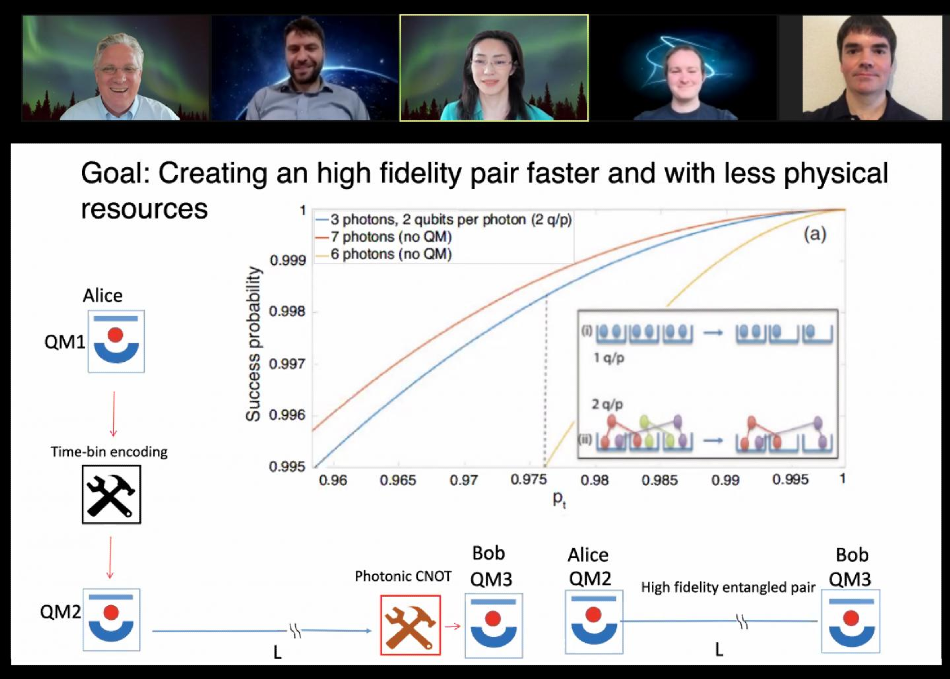Jul 17 2020
Everyone knows that the quantum world can transform communication technology. Quantum technology offers the potential of impenetrable security and unparalleled performance, and is taking its initial steps towards the decisive goal of applications such as extremely encrypted yet virtually fast-as-light financial transactions.
 A tele-meeting with the results: from left, William J. Munro, Nicolò Lo Piparo, Kae Nemoto, Michael Hanks, and Claude Gravel. Image Credit: Kae Nemoto, Global Research Center for Quantum Information Science, the National Institute of Informatics in Japan.
A tele-meeting with the results: from left, William J. Munro, Nicolò Lo Piparo, Kae Nemoto, Michael Hanks, and Claude Gravel. Image Credit: Kae Nemoto, Global Research Center for Quantum Information Science, the National Institute of Informatics in Japan.
But the potential for quantum computers to interact with each other has been restricted by the resources needed for such kinds of exchanges. This has consequently limited the proportion of data that can be traded, and also the amount of time it can be preserved.
Now, Japan-based researchers have taken a significant step toward dealing with such limitations in resources. The team has published its findings in the Physical Review Letters journal on May 27th, 2020.
To connect remote quantum computers together, we need the capacity to perform quantum mechanical operations between them over very long distances, all while maintaining their important quantum coherence.
Kae Nemoto, Study Author, Professor¸ and Director, Global Research Center for Quantum Information Science, National Institute of Informatics
Nemoto continued, “However, interestingly, while quantum computers have emerged at the small scale, quantum communication technology is still at the device level and has not been integrated together to realize communication systems. In this work, we show a route forward.”
Quantum data needs to be protected from the considerable level of noise surrounding it, and data is also likely to be lost from the preliminary message. Such a protection process is referred to as quantum error correction, which intertwines a single piece of data over several qubits. Qubits happen to be the most fundamental unit of quantum data.
Individuals can envision a letter shredded into nine pieces, with each piece placed inside an envelope and each envelope delivered to the same kind of destination to be again organized and read.
Similarly, in the quantum realm, the envelopes are sent through photons and each envelope contains a sufficient amount of data to reproduce the whole letter if any of the delivered envelopes are damaged or lost.
The overhead to protect quantum information from noise and loss will be large, and the size of the required devices to realize this will cause serious problems, as we have started to see in today's quantum computer development. As the efforts to realize the quantum internet are occurring worldwide, it is important to think of it as a system, and not simple devices.
Kae Nemoto, Study Author, Professor¸ and Director, Global Research Center for Quantum Information Science, National Institute of Informatics
Along with her research team, Nemoto tackled this problem by employing a procedure known as quantum multiplexing, where they decreased the noise and also the number of resources required to relay the data.
In multiplexing, the data stored inside a pair of individual photons is integrated into a single photon, similar to a couple of envelopes being delivered in a portfolio, and therefore, the data is still protected individually but only a single stamp is required to transmit the information.
In this system, quantum error correction will play an essential role, not only of protecting the quantum information transmitted, but also for significantly reducing the necessary resources to achieve whatever tasks one needs. Quantum multiplexing enables significant resource reduction without requiring new technology to be developed for such quantum communication devices.
William J. Munro, Study Co-Author and Researcher, Basic Research Laboratories, NTT
At present, the scientists are extending their study to large-scale quantum complex network situations.
“The quantum revolution has allowed us to design and create new technologies previously thought impossible in our classical world,” added Nemoto. “Small-scale quantum computers have already shown computing performance better than today’s largest supercomputers.”
“However, many other forms of quantum technology are emerging and one of the most profound could be the quantum internet— a quantum-enabled version of today’s internet—which will allow us to network devices together, including quantum computers,” Nemoto further stated.
The scientists will next build on the initial steps that they have already adopted to boost the amount of data as well as the storage time.
The study was partly funded by the Japan Society for the Promotion of Science and the John Templeton Foundation.
Others who contributed to the study are Nicolò Lo Piparo, Michael Hanks, Claude Gravel, and William J. Munro, all affiliated with the National Institute of Informatics. In addition, Munro is affiliated with the NTT Basic Research Laboratories as well as the NTT Research Center for Theoretical Quantum Physics.
Journal Reference:
Lo Piparo, N., et al. (2020) Resource Reduction for Distributed Quantum Information Processing Using Quantum Multiplexed Photons. Physical Review Letters. doi.org/10.1103/PhysRevLett.124.210503.